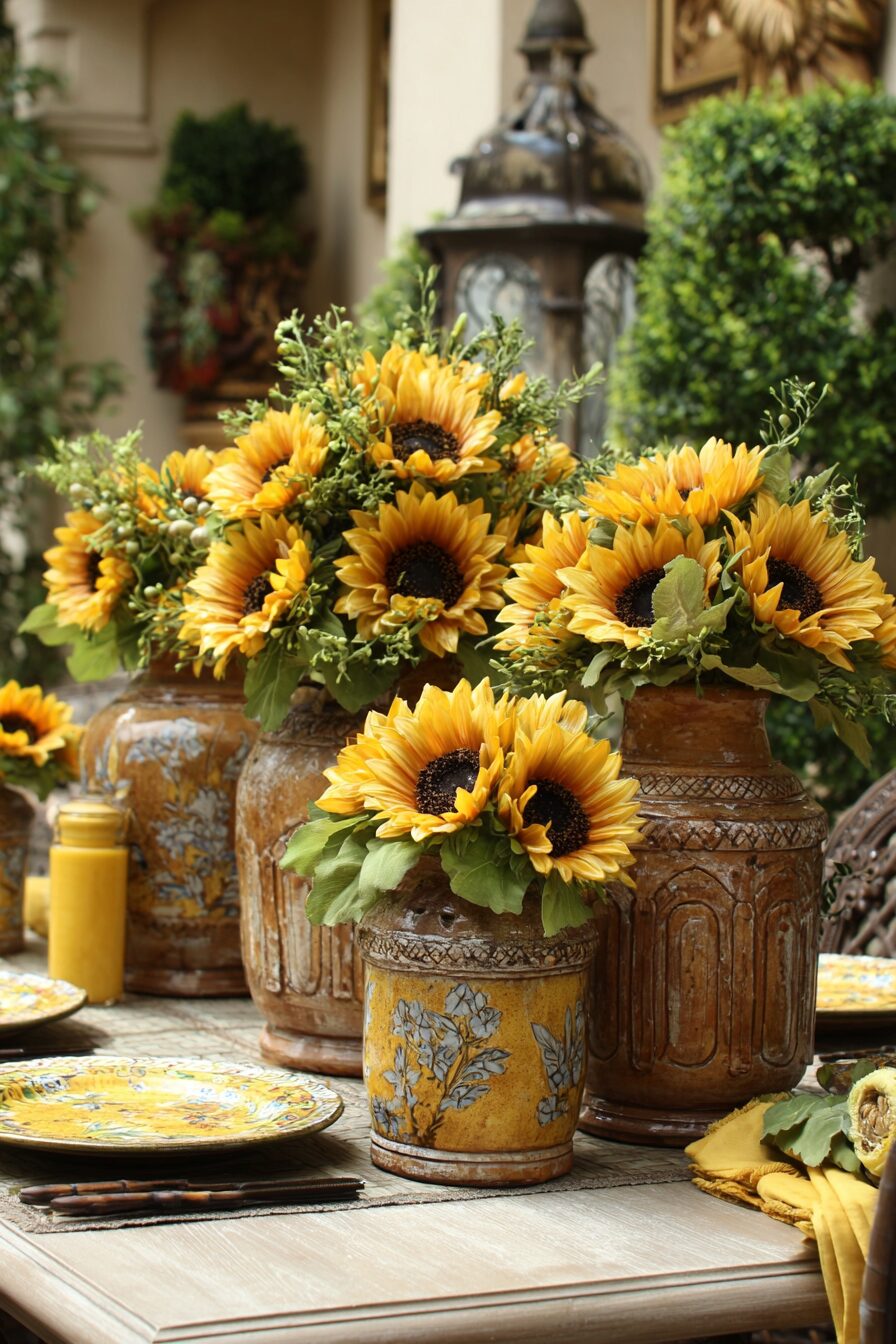There’s something absolutely magical about Italian dining culture that goes way beyond the incredible food.
It’s the warmth, the attention to detail, and that effortless elegance that makes every meal feel like a celebration.
If you’re hosting a dinner party or just want to bring some Mediterranean charm to your everyday dining, these Italian-inspired table decoration ideas will transport you and your guests straight to the cobblestone streets of Florence.
Rustic Olive Branch Centerpieces That Scream Authentic Italy
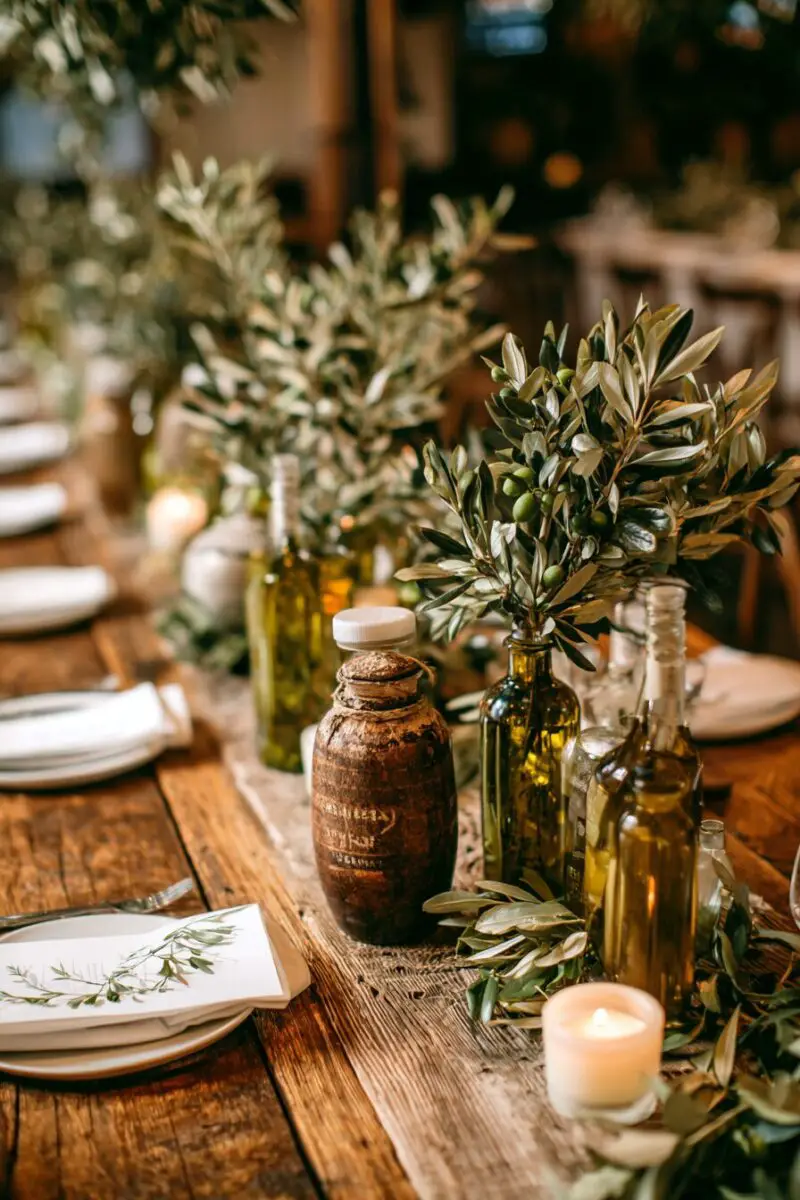
Picture this: you walk into a cozy trattoria in the Italian countryside, and the first thing that catches your eye is a gorgeous arrangement of silvery olive branches cascading down the center of every table.
Olive branches aren’t just beautiful – they’re deeply symbolic in Italian culture, representing peace, wisdom, and abundance.
You can create stunning centerpieces by gathering fresh olive branches from your local florist or Mediterranean garden center and arranging them in low, wide vessels.
The silvery-green leaves catch the light beautifully and create an organic, flowing look that feels both elegant and effortlessly casual.
Mix different heights by using varying lengths of branches, some reaching up while others drape gracefully over the edges of your containers.
For an extra touch of authenticity, incorporate small terra cotta pots filled with actual olive trees as mini centerpieces between place settings.
The key is to keep the arrangement low enough that your guests can easily see and talk to each other across the table.
You’ll want to mist the branches lightly before your guests arrive to keep them looking fresh and vibrant throughout the evening.
The beauty of olive branch centerpieces lies in their versatility – they work equally well for casual Sunday lunches and formal dinner parties.
Your guests will be amazed at how such a simple element can completely transform the atmosphere of your dining space.
Madison’s Current Obsessions
Which Dining Table Color Works Best with Your Dark Hardwood? 11+ Stunning IdeasVintage Italian Wine Bottles as Candlestick Holders

Nothing says “Italian romance” quite like the warm, flickering glow of candles nestled in empty Chianti bottles.
This classic decoration has been gracing Italian tables for decades, and there’s a good reason it never goes out of style.
Start collecting those beautiful bottles from your favorite Italian wines – Chianti Classico bottles with their distinctive straw basket bottoms are perfect, but any Italian wine bottle will work wonderfully.
The process is surprisingly simple: after enjoying the wine (the best part!), remove the labels by soaking the bottles in warm, soapy water.
Use a bottle cutter or carefully break the neck of the bottle to create the perfect height for taper candles.
Sand the edges smooth to ensure safety, and you’ve got yourself authentic Italian candlestick holders that cost almost nothing to make.
The beauty lies in the imperfection – each bottle will have its own character, creating a delightfully mismatched yet cohesive look.
Cluster different heights together for visual interest, mixing full-height bottles with shorter cut versions.
The green glass creates the most beautiful ambient lighting, casting a warm, romantic glow across your table.
For extra charm, let the wax drip naturally down the sides of the bottles – this is actually part of the authentic Italian aesthetic.
You can also wrap the bottles with raffia or twine for a more rustic look, or leave them clean and simple for modern elegance.
Design Your Dream Room in Minutes! By DreamyHomeStyle
🏡 Start Creating FREE →Madison’s Current Obsessions
Your Dining Room Looks Dated Next To These Contemporary Masterpieces.Hand-Painted Ceramic Plates That Tell a Story
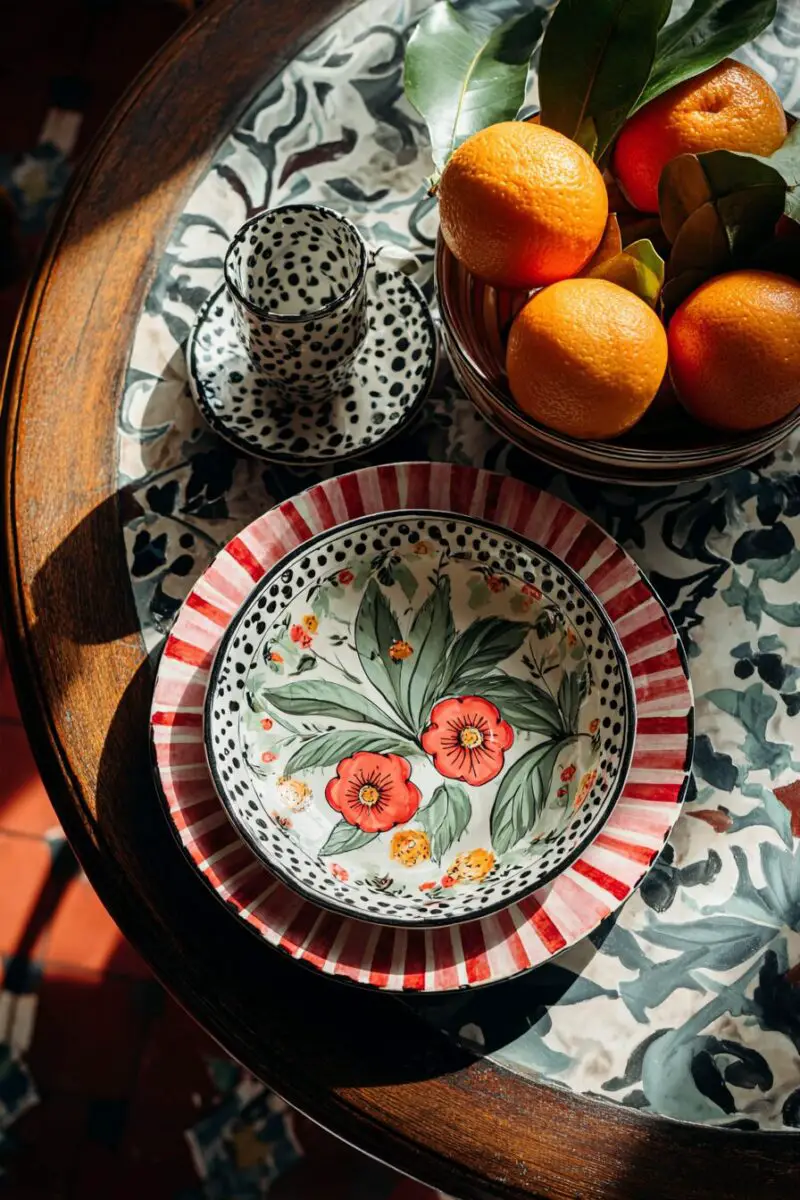
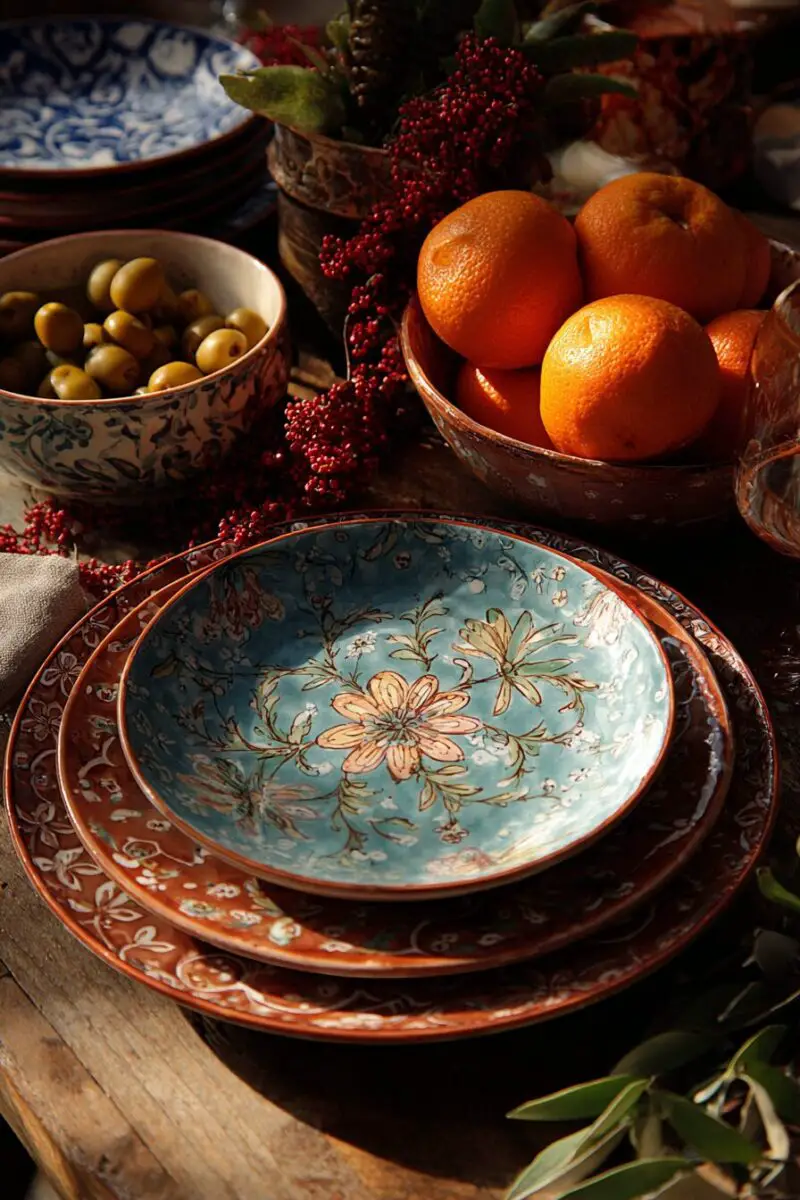
Walk into any Italian home, and you’ll immediately notice the stunning hand-painted ceramics that have been passed down through generations.
These aren’t just plates – they’re works of art that bring color, personality, and cultural heritage to every meal.
You don’t need to inherit family heirloom ceramics to achieve this look; you can find beautiful Italian-inspired hand-painted plates at antique shops, import stores, or even paint your own.
Look for pieces featuring classic Italian motifs like lemons from the Amalfi Coast, sunflowers from Tuscany, or the intricate geometric patterns of Sicilian ceramics.
The key is to embrace the slightly imperfect, handmade quality that makes each piece unique and full of character.
Mix and match different patterns and colors – Italians aren’t afraid of bold combinations, and neither should you be.
Combine bright yellow lemon patterns with deep blue Mediterranean designs, or pair rustic olive motifs with vibrant red tomato illustrations.
Each place setting can be different, creating a collected-over-time feel that’s quintessentially Italian.
Layer these decorative plates over simple white or cream chargers to make the painted designs really pop.
The beauty of this approach is that it works for both everyday dining and special occasions – simply add more layers and formal elements for fancier meals.
Your guests will love examining the different designs and hearing the stories behind each piece.
This style of table setting encourages conversation and creates a warm, welcoming atmosphere that’s perfect for long, leisurely Italian-style meals.
Madison’s Current Obsessions
Stylish Living/Dining Room Combo Ideas You'll LoveFresh Herb Potted Plants as Living Table Decor
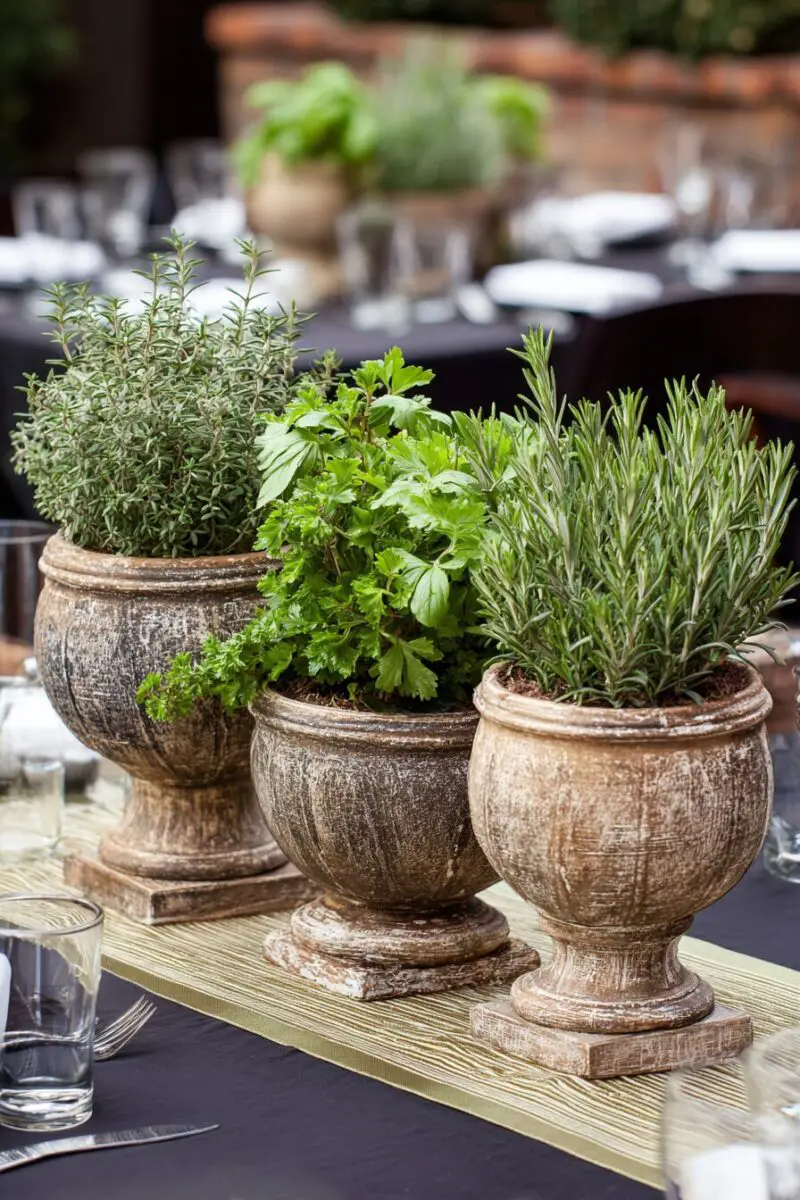
Imagine the intoxicating aroma of fresh basil, rosemary, and oregano wafting across your dinner table as you serve authentic Italian dishes.
Using potted herbs as table decorations is not only gorgeous but also incredibly practical – your guests can actually pinch off fresh herbs to enhance their meals.
Start with classic Italian herbs like basil, which comes in beautiful varieties from tiny-leafed Genovese to striking purple-ruffled types.
Rosemary adds height and a woodsy fragrance, while oregano spills beautifully over the edges of containers.
Plant these herbs in matching terra cotta pots of varying sizes, or for a more eclectic look, use vintage Italian olive oil cans or repurposed wine bottles cut in half.
The key is grouping them at different heights to create visual interest without blocking conversation across the table.
You can write the herb names on small chalkboard signs or tie rustic paper tags to each pot for a charming, garden-to-table feel.
Between dinner parties, these herbs can live on your kitchen windowsill, providing fresh ingredients for your cooking.
The living, growing element brings an organic vitality to your table that artificial decorations simply can’t match.
Encourage your guests to touch and smell the herbs – it’s an interactive element that adds another sensory dimension to the dining experience.
For evening dinners, tuck small battery-operated lights into the larger pots to create a magical, twinkling effect.
This approach works beautifully for outdoor dining as well, where the herbs can attract beneficial insects and create a true garden party atmosphere.
Madison’s Current Obsessions
13 Calming Japandi Dining Room Ideas With Perfect Color SchemesRustic Wooden Cutting Boards as Charming Charger Plates
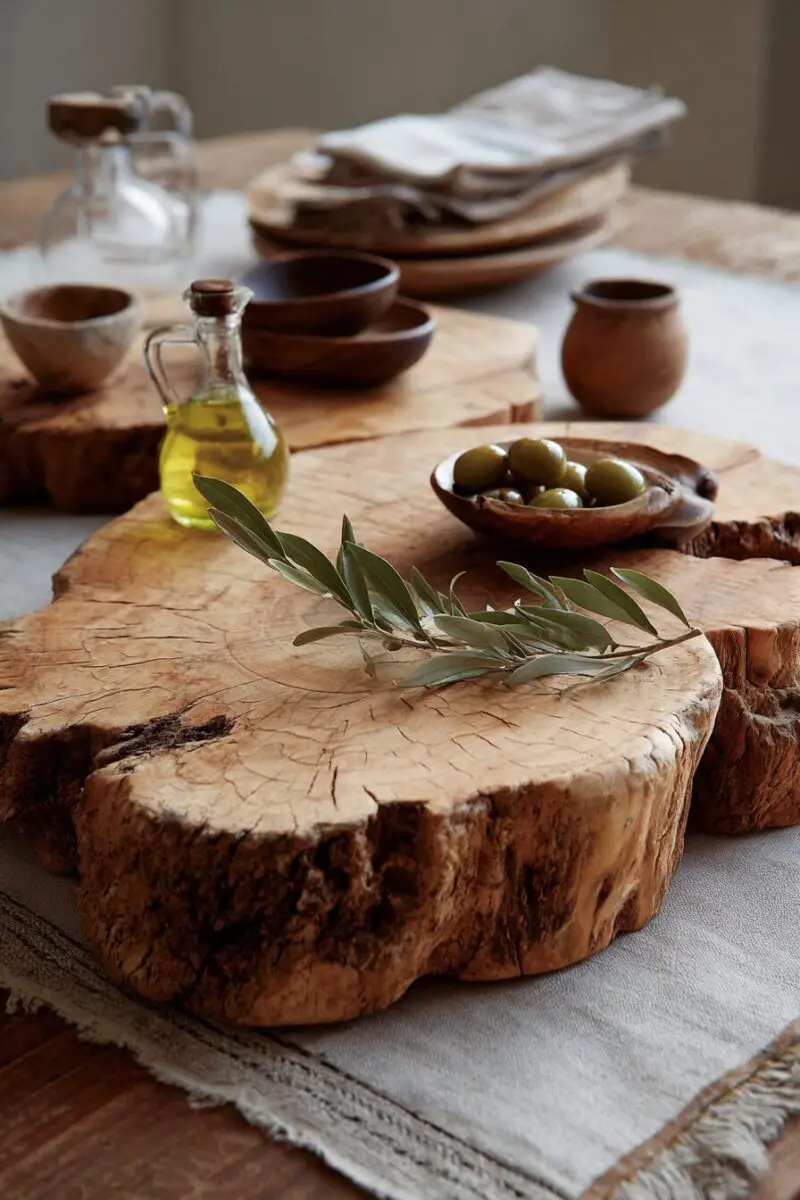
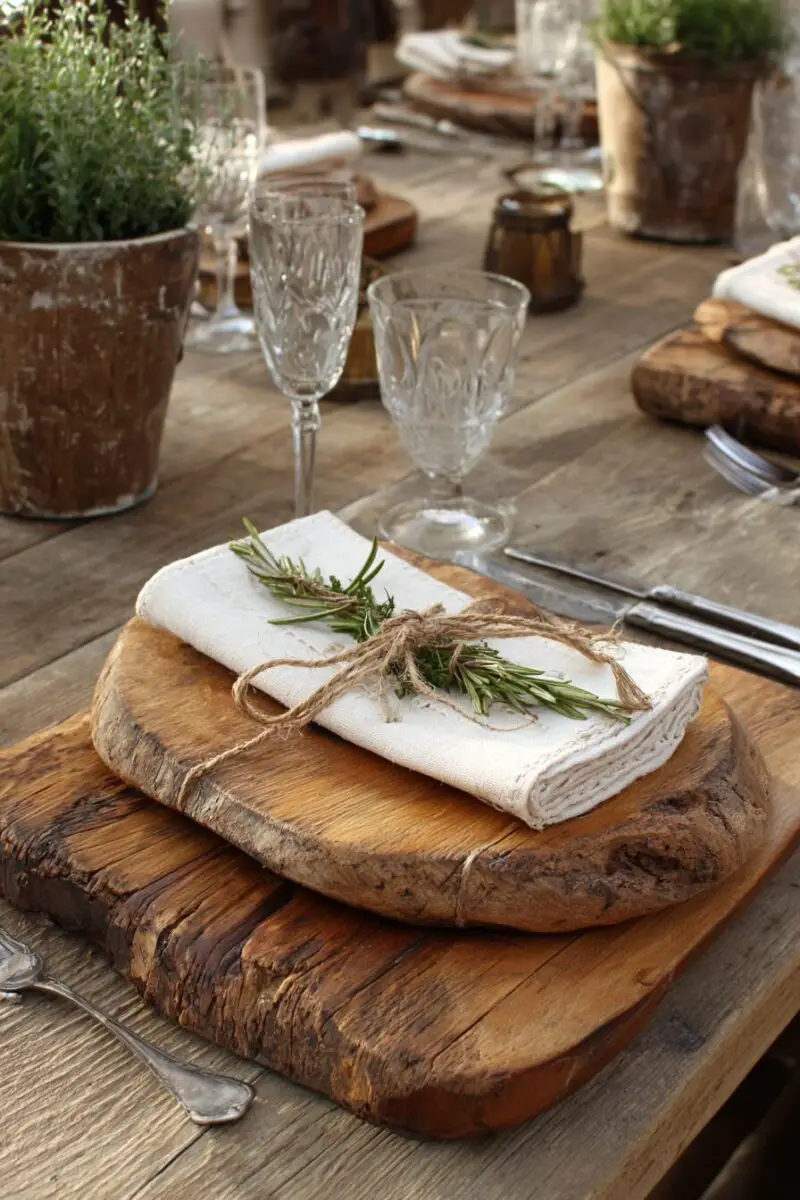
Transform ordinary dinner plates into something extraordinary by using authentic Italian wooden cutting boards as rustic charger plates.
This brilliant trick instantly adds warmth, texture, and that coveted farmhouse Italian aesthetic to any table setting.
Look for cutting boards made from olive wood, which is traditional in Italy and has the most beautiful grain patterns and natural golden coloring.
The varied shapes and sizes of different boards create an organic, collected-over-time look that’s impossible to achieve with matching manufactured chargers.
Each board tells its own story through the natural wood grain, knife marks, and patina that develops over time.
Layer your regular dinner plates on top of these wooden chargers, leaving a border of beautiful wood visible around the edges.
The contrast between the smooth ceramic plates and the rustic wood creates visual interest and depth.
For casual meals, you can actually use the boards functionally – serve cheese, bread, or antipasti directly on them before transitioning to the plated courses.
The natural antimicrobial properties of olive wood make these boards both beautiful and practical for food service.
Between uses, these cutting boards can display on open kitchen shelves or hang on walls as functional kitchen decor.
Mix different wood tones and sizes for an eclectic look, or stick to similar boards for a more cohesive aesthetic.
The key is embracing the imperfections and natural variations that make each piece unique and full of character.
Madison’s Current Obsessions
Create a Cozy Vibe With 13 Log Cabin Dining Room IdeasLemon and Citrus Garlands That Burst with Mediterranean Sunshine
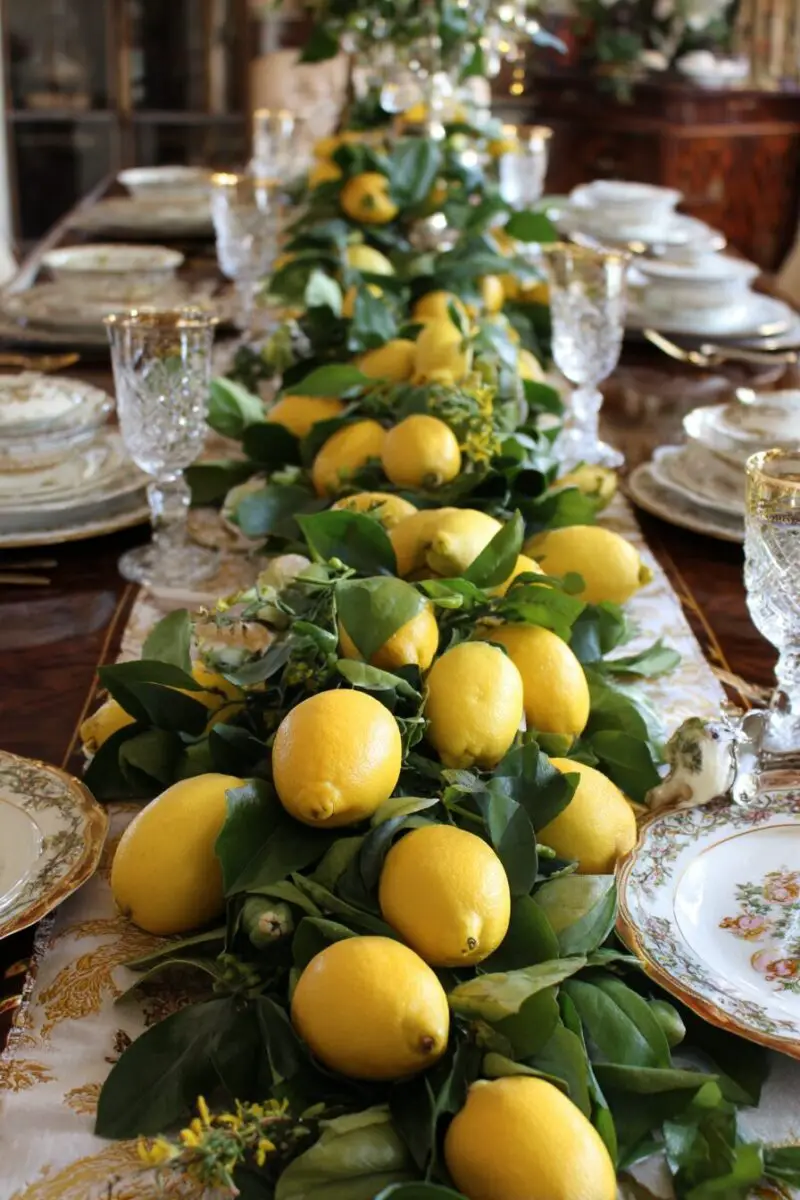
Nothing captures the essence of southern Italy quite like the bright, cheerful presence of fresh lemons adorning your dining table.
These sunshine-yellow fruits instantly transport your guests to the terraced hillsides of the Amalfi Coast or the grove-covered landscapes of Sicily.
Creating citrus garlands is surprisingly simple and creates maximum visual impact for minimal effort and cost.
Start with a variety of citrus fruits – bright yellow lemons, vibrant oranges, deep green limes, and if you can find them, the more exotic bergamot or blood oranges.
Thread a large needle with sturdy fishing line or thin floral wire and carefully pierce each fruit, creating garlands of varying lengths.
The key is mixing sizes and colors randomly rather than creating a perfect pattern – nature isn’t uniform, and neither should your garlands be.
Drape these garlands down the center of your table, allowing them to curve and flow naturally rather than lying flat and rigid.
The citrus oils released when you pierce the fruits will create a subtle, fresh fragrance that enhances the dining experience.
For longer tables, create multiple shorter garlands rather than one very long one, which can become unwieldy and difficult to manage.
You can also incorporate fresh bay leaves or small sprigs of rosemary between the fruits for added texture and Mediterranean authenticity.
The beautiful thing about citrus garlands is their versatility – they work equally well for casual outdoor lunches and elegant indoor dinner parties.
After your event, you can compost the fruits or use them for cooking, making this a completely sustainable decoration option.
Madison’s Current Obsessions
13 Chic Dining Table Decorations For Every StyleAntique Italian Maps and Vintage Travel Postcards as Table Runners

Transport your guests on a visual journey through Italy by using vintage maps and postcards as unique, conversation-starting table runners.
This creative approach to table decoration immediately sets a travel-inspired, nostalgic mood that’s perfect for Italian-themed dinners.
Scour antique shops, flea markets, or online vintage sellers for authentic Italian maps from different eras – the older and more weathered, the better.
Look for maps of specific regions like Tuscany, Sicily, or the Italian Riviera, or go with classic maps of the entire Italian peninsula.
The beautiful aged colors and intricate geographical details create a sophisticated backdrop for your place settings.
For a more eclectic approach, collect vintage Italian travel postcards and arrange them in overlapping patterns down the center of your table.
These postcards often feature stunning photography of famous landmarks, charming villages, or classic Italian scenes from the 1950s and 60s.
The smaller scale of postcards allows you to create more intimate, detailed displays that guests can examine closely.
Protect these vintage pieces by covering them with clear contact paper or having them laminated at a copy shop.
This protection allows you to use them multiple times and makes cleanup easy after messy meals.
Mix maps and postcards together for a layered, collected-over-time aesthetic that suggests years of Italian travels and adventures.
Your guests will spend time studying the details, sharing their own Italian travel experiences, and planning future trips based on the places they see displayed.
Madison’s Current Obsessions
13 Fall Table Settings To Inspire Your Next DinnerTerra Cotta Planters Filled with Tuscan Sunflowers
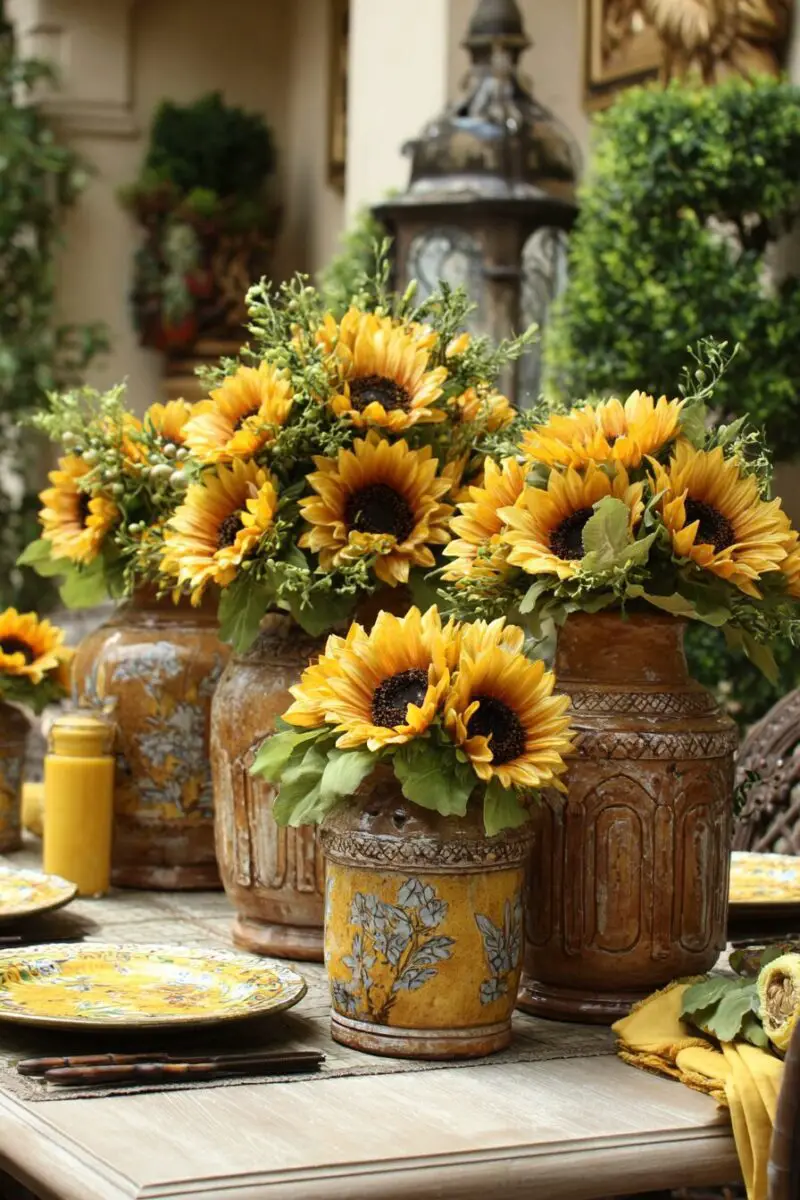
Few flowers capture the essence of rural Italy quite like the magnificent sunflower, with its bold yellow petals and impressive size reaching toward the Mediterranean sun.
These cheerful giants instantly transform any dining space into a Tuscan farmhouse, creating a warm, welcoming atmosphere that encourages long, leisurely meals.
Choose terra cotta planters in various sizes to create visual interest and accommodate sunflowers at different stages of bloom.
The earthy, natural color of terra cotta complements the golden yellows of sunflowers perfectly while maintaining that authentic Italian aesthetic.
Mix full-sized sunflowers with smaller varieties like teddy bear sunflowers or sunflower buds for a more dynamic, garden-fresh arrangement.
The key is creating height variation without blocking sight lines across the table – use taller arrangements at the ends and shorter ones in the center.
Sunflowers have relatively short vase lives, but their dramatic impact makes them worth the investment for special occasions.
To extend their freshness, cut the stems at an angle under running water and change the water in your planters every couple of days.
The large flower heads create natural conversation pieces, and guests often find themselves drawn to touch the textured centers and examine the intricate petal patterns.
For evening dinners, place small votive candles around the base of each planter to create warm, flickering light that highlights the flowers’ golden colors.
Between dinner parties, these terra cotta planters can be repurposed for growing herbs or small vegetables, extending their usefulness beyond table decoration.
The rustic, farmhouse charm of this arrangement works particularly well for outdoor dining or casual indoor gatherings with a country Italian theme.
Madison’s Current Obsessions
These Luxe Dining Room Christmas Ideas Are Going ViralVintage Italian Lace Tablecloths with Modern Twists
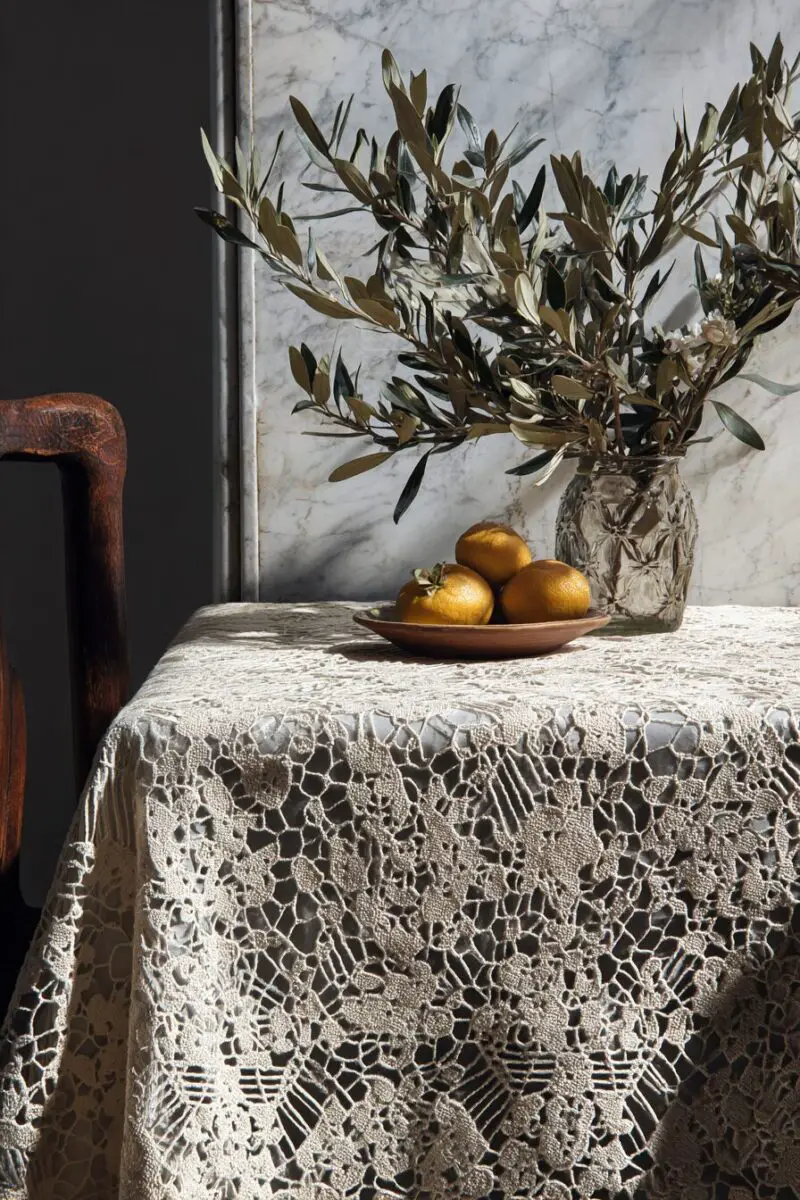
There’s something timelessly elegant about the intricate beauty of authentic Italian lace that instantly elevates any table setting from ordinary to extraordinary.
These delicate textiles, often passed down through generations of Italian families, bring a sense of history and craftsmanship to modern dining.
Hunt for genuine vintage pieces at estate sales, antique shops, or specialty textile dealers – the slight imperfections and signs of age only add to their charm and authenticity.
Look for pieces featuring traditional Italian lace-making techniques like Burano point lace or Venetian needle lace, each with distinctive patterns and regional characteristics.
The beauty of vintage lace lies in its versatility – it can serve as a full tablecloth for formal occasions or be layered over solid-colored linens for textural interest.
For a modern twist, use smaller lace pieces as placemats or table runners, mixing them with contemporary elements like sleek glassware or minimalist ceramic dishes.
The contrast between the intricate, old-world lace and clean, modern table elements creates a sophisticated, curated look that feels both historic and current.
Don’t be afraid to mix different lace patterns and ages – the slightly mismatched aesthetic is actually more authentic to how these pieces would have been collected over time.
For casual dining, layer lace over burlap or rough linen for a rustic-meets-elegant aesthetic that’s perfect for farmhouse-style Italian meals.
The delicate patterns cast beautiful shadows when lit by candles, creating an additional layer of visual interest as the evening progresses.
Care for these precious textiles properly by hand-washing in cool water and laying flat to dry, ensuring they’ll continue to grace your table for years to come.
Madison’s Current Obsessions
13 Cozy Vintage Dining Room Inspirations That Feels Like HomeHandmade Pasta Displayed as Edible Art Centerpieces
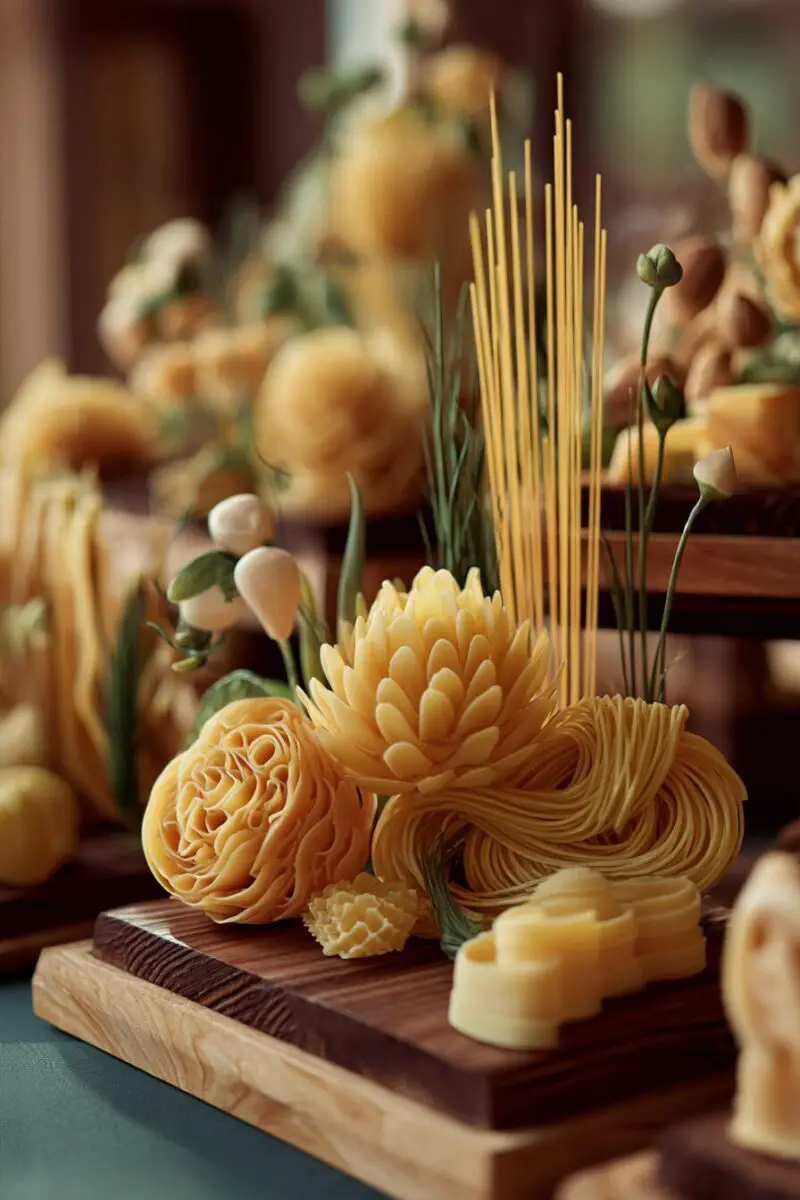
Turn the process of making fresh pasta into a stunning visual display that serves as both decoration and the foundation for your Italian feast.
This interactive approach to table decoration allows your guests to witness the artistry and tradition behind authentic Italian pasta-making while creating anticipation for the meal ahead.
Set up a dedicated pasta-making station at one end of your table with wooden boards, rolling pins, and small bowls of semolina flour for dusting.
Display different shapes of freshly made pasta on large wooden cutting boards or woven baskets lined with clean kitchen towels.
Arrange long strands of fresh tagliatelle in loose nests, showcase the elegant curves of handmade tortellini, or display the rustic charm of fresh orecchiette.
The golden color and organic shapes of fresh pasta create beautiful, sculptural elements that are completely unique to Italian cuisine.
Sprinkle the pasta lightly with semolina flour to prevent sticking and to create an authentic, just-made appearance.
Small cards describing each pasta shape and its traditional uses add an educational element that guests will appreciate.
The different textures and forms create visual interest while the subtle aroma of fresh pasta adds another sensory dimension to your table setting.
This approach works particularly well for interactive dinner parties where guests can help shape pasta or watch the process unfold.
As the evening progresses, you can cook portions of the displayed pasta as appetizers or incorporate them into the main meal.
The ephemeral nature of this decoration – knowing it will be eaten – adds a special poignancy and celebration of the moment that’s deeply Italian in spirit.
Creating an authentic Italian dining atmosphere is all about embracing warmth, tradition, and the beauty found in everyday objects.
These decoration ideas prove that you don’t need expensive imports or formal training to bring the magic of Italy to your own dining room.
The key is mixing natural elements, vintage finds, and handmade touches to create a space that feels both elegant and welcoming – just like the best Italian homes.

